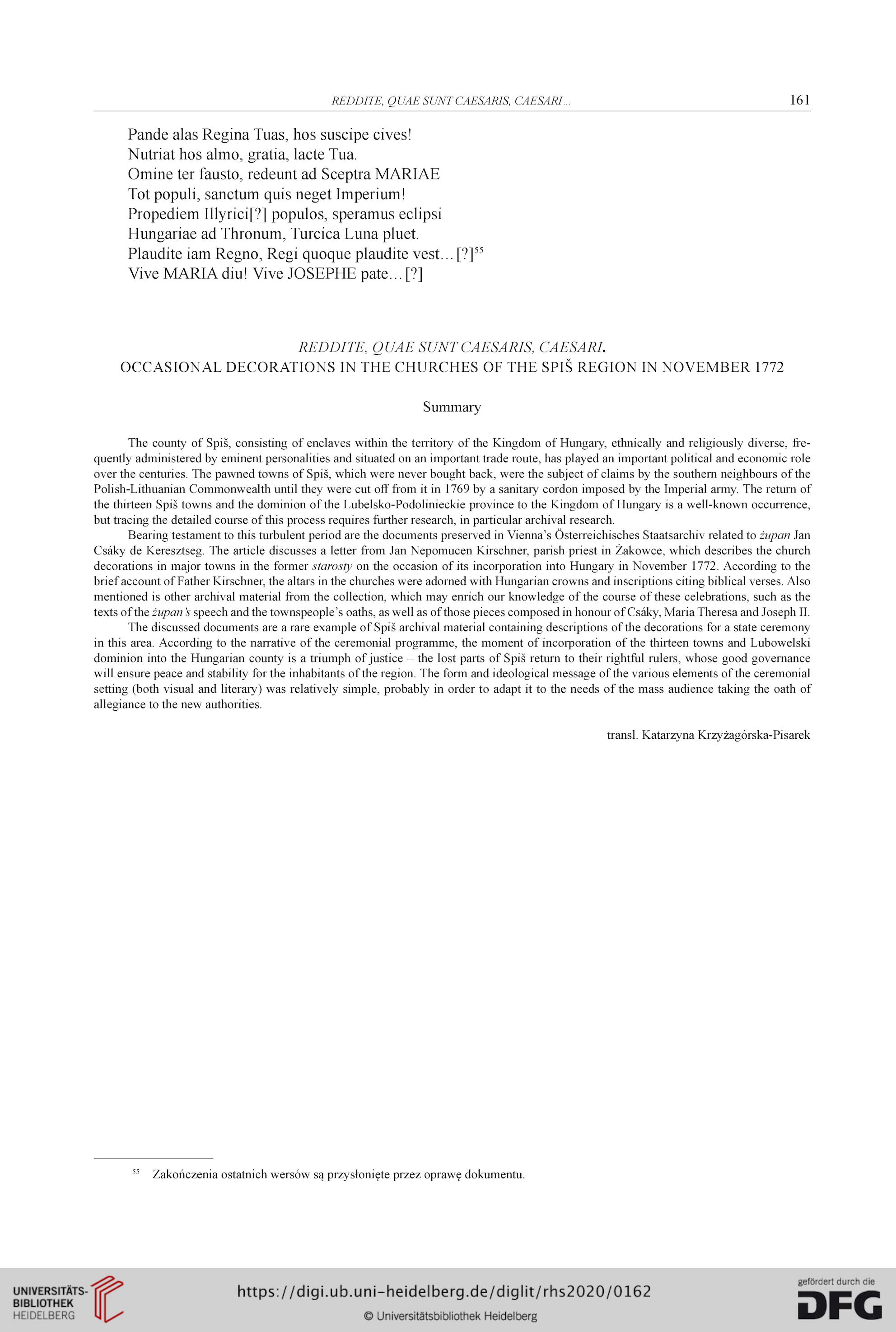REDDITE, QUAE SUNT CAESARIS, CAESARI...
161
Pande alas Regina Tuas, hos suscipe cives!
Nutriat hos almo, gratia, lacte Tua.
Omine ter fausto, redeunt ad Sceptra MARIAE
Tot populi, sanctum quis neget Imperium!
Propediem Illyricif?] populos, speramus eclipsi
Hungariae ad Thronum, Turcica Luna pluet.
Plaudite iam Regno, Regi quoque plaudite vest... [?]55
Vive MARIA diu! Vive JOSEPHE pate... [?]
REDDITE, QUAE SUNT CAESARIS, CAESARI.
OCCASIONAL DECORATIONS IN THE CHURCHES OF THE SPIŚ REGION IN NOVEMBER 1772
Summary
The county of Spis, consisting of enclaves within the territory of the Kingdom of Hungary, ethnically and religiously diverse, fre-
quently administered by eminent personalities and situated on an important hade route, has played an important political and economic role
over the centuries. The pawned towns of Spis, which were never bought back, were the subject of claims by the southern neighbours of the
Polish-Lithuanian Commonwealth until they were cut off from it in 1769 by a sanitary cordon imposed by the Imperial army. The return of
the thirteen Spis towns and the dominion of the Lubelsko-Podolinieckie province to the Kingdom of Hungary is a well-known occurrence,
but fracing the detailed course of this process requires further resear ch, in particular' ar chival resear ch.
Bearing testament to this turbulent period ar e the documents preserved in Vienna’s Österreichisches Staatsarchiv related to żupan Jan
Csàky de Keresztseg. The article discusses a letter from Jan Nepomucen Kirschner, parish priest in Żakowce, which describes the church
decorations in major towns in the former starosty on the occasion of its incorporation into Hungary in November 1772. According to the
brief account of Father Kirschner, the altar s in the churches were adorned with Hungar ian crowns and inscriptions citing biblical verses. Also
mentioned is other ar chival material from the collection, which may enrich our knowledge of the course of these celebrations, such as the
texts of the żupan ’s speech and the townspeople’s oaths, as well as of those pieces composed in honour of Csàky, Maria Theresa and Joseph II.
The discussed documents ar e a rar e example of Spis ar chival material containing descriptions of the decorations for a state ceremony
in this ar ea. According to the narrative of the ceremonial programme, the moment of incorporation of the thirteen towns and Lubowelski
dominion into the Hungar ian county is a triumph of justice - the lost parts of Spis return to their rightful rulers, whose good governance
will ensure peace and stability for the inhabitants of the region. The form and ideological message of the var ious elements of the ceremonial
setting (both visual and literary) was relatively simple, probably in order to adapt it to the needs of the mass audience taking the oath of
allegiance to the new authorities.
fransi. Katarzyna Krzyżagórska-Pisarek
55 Zakończenia ostatnich wersów są przysłonięte przez oprawę dokumentu.
161
Pande alas Regina Tuas, hos suscipe cives!
Nutriat hos almo, gratia, lacte Tua.
Omine ter fausto, redeunt ad Sceptra MARIAE
Tot populi, sanctum quis neget Imperium!
Propediem Illyricif?] populos, speramus eclipsi
Hungariae ad Thronum, Turcica Luna pluet.
Plaudite iam Regno, Regi quoque plaudite vest... [?]55
Vive MARIA diu! Vive JOSEPHE pate... [?]
REDDITE, QUAE SUNT CAESARIS, CAESARI.
OCCASIONAL DECORATIONS IN THE CHURCHES OF THE SPIŚ REGION IN NOVEMBER 1772
Summary
The county of Spis, consisting of enclaves within the territory of the Kingdom of Hungary, ethnically and religiously diverse, fre-
quently administered by eminent personalities and situated on an important hade route, has played an important political and economic role
over the centuries. The pawned towns of Spis, which were never bought back, were the subject of claims by the southern neighbours of the
Polish-Lithuanian Commonwealth until they were cut off from it in 1769 by a sanitary cordon imposed by the Imperial army. The return of
the thirteen Spis towns and the dominion of the Lubelsko-Podolinieckie province to the Kingdom of Hungary is a well-known occurrence,
but fracing the detailed course of this process requires further resear ch, in particular' ar chival resear ch.
Bearing testament to this turbulent period ar e the documents preserved in Vienna’s Österreichisches Staatsarchiv related to żupan Jan
Csàky de Keresztseg. The article discusses a letter from Jan Nepomucen Kirschner, parish priest in Żakowce, which describes the church
decorations in major towns in the former starosty on the occasion of its incorporation into Hungary in November 1772. According to the
brief account of Father Kirschner, the altar s in the churches were adorned with Hungar ian crowns and inscriptions citing biblical verses. Also
mentioned is other ar chival material from the collection, which may enrich our knowledge of the course of these celebrations, such as the
texts of the żupan ’s speech and the townspeople’s oaths, as well as of those pieces composed in honour of Csàky, Maria Theresa and Joseph II.
The discussed documents ar e a rar e example of Spis ar chival material containing descriptions of the decorations for a state ceremony
in this ar ea. According to the narrative of the ceremonial programme, the moment of incorporation of the thirteen towns and Lubowelski
dominion into the Hungar ian county is a triumph of justice - the lost parts of Spis return to their rightful rulers, whose good governance
will ensure peace and stability for the inhabitants of the region. The form and ideological message of the var ious elements of the ceremonial
setting (both visual and literary) was relatively simple, probably in order to adapt it to the needs of the mass audience taking the oath of
allegiance to the new authorities.
fransi. Katarzyna Krzyżagórska-Pisarek
55 Zakończenia ostatnich wersów są przysłonięte przez oprawę dokumentu.




